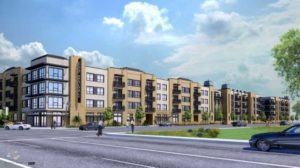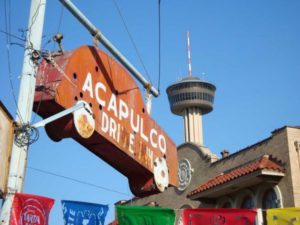Robert Rivard, formerly with The Express-News, has launched a new blog devoted to extending the discussion to all things related to San Antonio’s revitalization of our downtown core. Check it out here. You can also sign up to be a contributor.
Robert Rivard, formerly with The Express-News, has launched a new blog devoted to extending the discussion to all things related to San Antonio’s revitalization of our downtown core. Check it out here. You can also sign up to be a contributor.
Our city leaders, county leaders, and VIA have secured the funds to begin construction of San Antonio’s new streetcar system. Vianna Davila explains in this article for the Express-News how they were able to do it.
County and VIA Metropolitan Transit officials have identified enough local funds to build the city’s first two streetcar lines without help from the federal government.
They will announce the funding strategies and how they cobbled together the $59 million they needed to finish the system at a news conference today.The total cost for VIA’s expansion is $239 million, which includes money for two downtown streetcar lines running north and east, and west and south, plus a slew of other transit projects in and beyond downtown.
Here’s a report on a new apartment project being built on Broadway and E. Grayson across from the Pearl. Work is well under way at this point. Also cool that my friend, Patrick Shearer, had a quote in the article.
A new development that offers luxury living is moving into an area along Broadway that has seen a boom in residential construction.
Work already has started on the 1800 Broadway, a multifamily project that will become part of the redevelopment and urbanization efforts along the northern stretch of the River Walk.

The 1800 Broadway will be comprised of 230-unit luxury apartment homes located just north of downtown near the Pearl Brewery. The project is expected to be completed in March 2013. ILLUSTRATION COURTESY OF CRITERION DEVELOPMENT PARTNERS Photo: CRITERION DEVELOPMENT PARTNERS, COURTESY ILLUSTRATION
Situated at the corner of Broadway and East Grayson Street, the four-story complex, which boasts a modernized art deco design, will offer 230 luxury apartments, said W. Pretlow Riddick, principal and president of Criterion Development Partners, one of the firms developing the project.
As San Antonio begins to rebuild our streetcar system it’s important to reflect on how the streetcars of the past helped shape our center city. This is a good piece written by Christine Vina.
Written by Christine Vina and posted in the San Antonio Express-News on November 27, 2011
If you take a look at the streetcar map of early 1920s San Antonio, it is quite easy to identify the neighborhoods that were connected by the 19 different streetcar lines that existed at the time. If one lived or worked within the original 36 square miles of the city (roughly the area bounded by Hildebrand Avenue, Rio Grande, Division/Morill Avenues, and 19th/24th streets), you were ‘free’ to travel around the city, and the local commerce located along these major transit routes offered additional economic development benefits to the community.
Two story dream home in Lavaca priced to move quickly. Completely renovated home sits on large lot and features a contemporary kitchen with Bosch appliances, tankless water heater, insulated walls, spray foam insulated attic and sub-floor, high efficiency HVAC system, new concrete pier foundation, new electric system, new plumbing, and more. Private master suite upstairs is stunning with cedar added to mimic exposed rafters. Seller renovated 123 Panama and many others in Southtown. Come take a look.
Click on the photo for more pictures and information about the home.
The main reason Zillow and Trulia do not work in Texas is that we are a non-disclosure state in regard to home sales prices. Zillow and Trulia pull their data from county records and in TX that data is based on county appraisals and not actual sales prices. Bexar County Appraisal District can do a fairly decent job of appraising new suburban construction but it is very difficult to accurately determine true value in older neighborhoods where the housing stock will vary widely in quality of renovations or lack thereof. If you’re looking to determine true market value of a home it is best to consult a real estate professional that knows your neighborhood and has access to comparable properties both actively on the market and those that have recently sold.
Jason Gonsalves worked hard to turn his 6,500-square-foot stucco-and-stone home in the suburbs of Sacramento into the ultimate grown-up party pad, complete with game room, custom wine cellar and an infinity-edge pool overlooking Folsom Lake. When interest rates fell recently, Mr. Gonsalves, who runs a lobbying firm, looked into refinancing his $750,000 mortgage. That’s when he got startling news—the home had dropped more than $200,000 in value while he was renovating.
Or at least, that’s what one real-estate website told him. Another valued the house at only $640,500. And these online estimates left him all the more confused when a real-life appraiser, assessing the house for the refinancing loan, pinned its value at $1.5 million. “I have no idea how those numbers could be so different,” Mr. Gonsalves says.
This op-ed piece was recently posted in The New York Times. I see San Antonio moving in the direction he speaks of with our city, county, and VIA electing to move forward with their light rail plans and also with the continued work of the HemisFair Park Area Redevelopment Corporation as they finish their master plan that will lay out the future renewal of HemisFair.
DRIVE through any number of outer-ring suburbs in America, and you’ll see boarded-up and vacant strip malls, surrounded by vast seas of empty parking spaces. These forlorn monuments to the real estate crash are not going to come back to life, even when the economy recovers. And that’s because the demand for the housing that once supported commercial activity in many exurbs isn’t coming back, either.
By now, nearly five years after the housing crash, most Americans understand that a mortgage meltdown was the catalyst for the Great Recession, facilitated by underregulation of finance and reckless risk-taking. Less understood is the divergence between center cities and inner-ring suburbs on one hand, and the suburban fringe on the other.
It was predominantly the collapse of the car-dependent suburban fringe that caused the mortgage collapse.
Preservationists’ dream featured in the 2011 Mahncke Park Home Tour. Built by notable developer H.C. Thorman in 1925, the two-story home maintains its historic charm while including modern amenities such as an open floor plan, dual-room master suite (convertable back to 3rd bedroom), & insulated exterior walls. Owner created larger master & has original materials to return back to three bedroom if needed. Numerous windows flood the home with natural light. Sited on a deep lot & a quiet street yet only minutes to Brackenridge Park, Ft. Sam Houston, The Pearl Farmer’s Market, Trinity University, UIW, Downtown, & more. Come take a look.
Click on the photo for more pictures and information about the house.

Acapulco Drive Inn in Southtown
I have somewhat mixed emotions on the closing of Acapulco Drive Inn. On the days it was open (very sporadically) it was a great place for neighbors to gather and catch up. I have a couple of neighbors that swear their dog would not let them walk by without them first stopping for a beer. It was a great place to stop by before or after walking to NIOSA or other Fiesta Events.
If you’re looking for another great neighborhood ice house to fill the void be sure to check out The Friendly Spot Ice House in the heart of Southtown. http://www.thefriendlyspot.com/
My hope is that the now vacant Acapulco will be taken over by another group that will fully utilize its prime location at the entrance of Southtown and add some vibrancy to the space.
This article in the Express-News does a good job of explaining the history of Acapulco Drive Inn, the role of an ice house, and the reason it is closing down.

HemisView Farmers Market Nov 4th